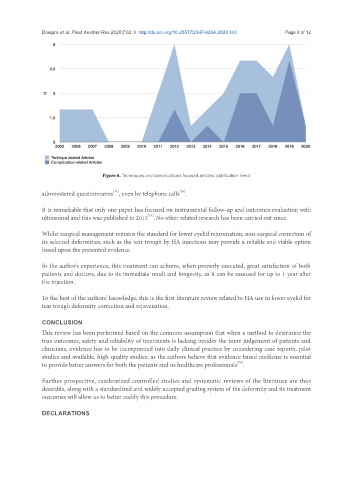Page 733 - Read Online
P. 733
Diaspro et al. Plast Aesthet Res 2020;7:62 I http://dx.doi.org/10.20517/2347-9264.2020.143 Page 9 of 12
Figure 6. Techniques and complications focused articles: publication trend
[26]
[71]
administered questionnaires , even by telephone calls .
It is remarkable that only one paper has focused on instrumental follow-up and outcomes evaluation with
[73]
ultrasound and this was published in 2013 .No other related research has been carried out since.
Whilst surgical management remains the standard for lower eyelid rejuvenation, non-surgical correction of
its selected deformities, such as the tear trough by HA injections may provide a reliable and viable option
based upon the presented evidence.
In the author’s experience, this treatment can achieve, when properly executed, great satisfaction of both
patients and doctors, due to its immediate result and longevity, as it can be assessed for up to 1 year after
the injection.
To the best of the authors’ knowledge, this is the first literature review related to HA use in lower eyelid for
tear trough deformity correction and rejuvenation.
CONCLUSION
This review has been performed based on the common assumption that when a method to determine the
true outcomes, safety and reliability of treatments is lacking besides the mere judgement of patients and
clinicians, evidence has to be incorporated into daily clinical practice by considering case reports, pilot
studies and available, high-quality studies, as the authors believe that evidence based medicine is essential
[79]
to provide better answers for both the patients and us healthcare professionals .
Further prospective, randomized controlled studies and systematic reviews of the literature are thus
desirable, along with a standardized and widely-accepted grading system of the deformity and its treatment
outcomes will allow us to better codify this procedure.
DECLARATIONS

